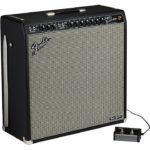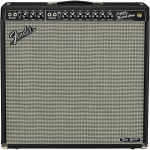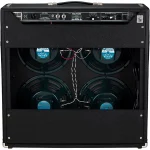 Guitar players at the two sides of the extremes of tone can fall into two camps when it comes to amplification. First, they can be the purist traditionalists who refuse to play nothing else unless they use vacuum tubes as they are after all “the real thing” those silly tech modelers try to imitate. Or, they can embrace all new forms of technology of modeling and solid state, and at the most extreme, go down that endless rabbit hole of options by spending more time playing with tech rather than playing their instrument.
Guitar players at the two sides of the extremes of tone can fall into two camps when it comes to amplification. First, they can be the purist traditionalists who refuse to play nothing else unless they use vacuum tubes as they are after all “the real thing” those silly tech modelers try to imitate. Or, they can embrace all new forms of technology of modeling and solid state, and at the most extreme, go down that endless rabbit hole of options by spending more time playing with tech rather than playing their instrument.
For most of us who comfortably fit somewhere between these extremes, we may have a preference for tube amps, but recognize the convenience and options that new technology has brought us – especially over the course of the last decade. Perhaps some of us just want great tones, but we don’t want to go through endless menus and patches. Instead of a jack-of-all trades but master-of-none amp, how about a really good, solid, base tone we can build off of?
 Enter the Fender Tone Master series of amps. Its mission is to give players all the best of what they want in an amp and take away the things they don’t. No excessive controller parameters or complex menus: check. No tube maintenance and cost: check. Light weight: check. Affordably-priced: check. Lastly and most importantly…great tone: a confirmed CHECK with some notes below.
Enter the Fender Tone Master series of amps. Its mission is to give players all the best of what they want in an amp and take away the things they don’t. No excessive controller parameters or complex menus: check. No tube maintenance and cost: check. Light weight: check. Affordably-priced: check. Lastly and most importantly…great tone: a confirmed CHECK with some notes below.
The front panel of the Super Reverb looks just like its tube-equipped cousin, with four inputs, two separate channels for Normal and Vibrato, as well as the same assortment of Volume and Tone controls, as well as Reverb and Vibrato Speed and Intensity controls and bright switches.
The rear panel is where things get more interesting. Next to the Power switch, and in lieu of the typical tube amp’s standby switch is the Mute switch. This enables one to  use the included XLR balanced output and shut off the internal speakers of the amp for silent recording. The output is equally useful for running direct into a PA system if you want to limit the use of additional microphones on stage. Cabinet sim software is included and switchable for either application.
use the included XLR balanced output and shut off the internal speakers of the amp for silent recording. The output is equally useful for running direct into a PA system if you want to limit the use of additional microphones on stage. Cabinet sim software is included and switchable for either application.
Also included on the rear panel is an Output Power control, which serves as a type of attenuator with several step-down power options ranging from a full 45W down to 1/2W of power.
Our test Tone Master series Super Reverb amp is a feature-rich amp suitable for gigging use at a very comfortable 37 lbs, or nearly half the weight of its all-tube cousin. It is loaded with the same Jensen P10R alnico speakers, comes with a two-button footswitch for Reverb and Vibrato, and has a standard 5-Year warranty.
But what’s it sound like? How close is it to the tube Super Reverb?
Well, I did let the cat out of the bag that it had great tone. And certainly as a clean platform amp, the response of the tone controls and the bright switch are spot-on. Plugging in an old Rat distortion pedal and using a Stratocaster, the tone and feel of the amp was wonderful and was just like “the real thing” in this application with the volume hovering around 3 and the amp running at full power. And when you have a distortion running on the front and you click the Bright Switch on, it responded just like the original tube model as well. So kudos for the Fender team at doing a VERY convincing job on the overall clean tone and the tone stack controls in this Tone Master series. It’s spot on.
The Reverb and Vibrato effects are nicely done as well, especially knowing that these are done in software. The merging of digital software into a an actual hardware amplification unit that is coming out of guitar speakers rather than a high-fi studio monitoring system enhances the feel of this amp being more true and organic to the real thing.
The next test was to crank up the amp a bit and run a Tube Screamer into it, ala Stevie Ray Vaughan tones. Setting the amp to 5, the sound when breaking up was pleasing to the ear, but not as convincing as a tube model Super Reverb. This is where I would rate it as overall well done, but with some areas missing. That said, when you are pushing a tube amplifier, you have to know it’s the combination of power tube compression, rectifier tube sag, output transformer saturation, and speaker breakup that provide the sound. That’s a tall order to try and mimic. So nailing that perfectly would be a very difficult, perhaps impossible task. And while the Tone Master Super Reverb definitely distorts, it remains a little cleaner and doesn’t quite provide the level of sag and bloom feel response you would get when pushing the tube version.
That said, this isn’t a knock on the Tone Master Super Reverb, because the breakup it does provide is nice and musically pleasing to the ear. This is not old-school solid state with all its harsh artifacts. And when you play with the options to bring down the power output and really drive the amp, you can’t argue against the myriad of cool things you can do with this amp at more comfortable levels versus the tube model which will need to be at full output. I had a LOT of fun playing with the settings down to 5W and really enjoyed experimenting with pushing the volume control while not punishing my ears. The lower 1W and 1/2W settings certainly brought the levels down dramatically further, but I felt something was also lost on these settings personally, whereas 5W and up is consistently good.
As a gigging amplifier, the mid-powered tube version of the Super Reverb or the 2×12 Pro Reverb are considered classic choices since they can serve as either great clean platforms or for use as on-the-edge of breakup tones that sit perfectly in the mix. And now the Tone Master series Super Reverb brings you those capabilities along with more modern enhancements. And at a $1199 Street price as of late 2021, The Tone Master Super Reverb is also a great bargain – especially for those who still want to enjoy the tone and overall feel of using an actual guitar amplifier in their backline.